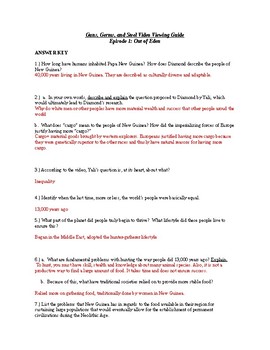Imagine a world where your potential for success is heavily influenced by the land you were born on. Not just your personal potential, but the potential of your entire civilization. This is the fascinating premise of Jared Diamond’s groundbreaking book, “Guns, Germs, and Steel,” and the subject of its second episode: The Geography of Destiny. In this episode, the story dives deep into how geographical factors, often overlooked in our discussions of history, played a pivotal role in determining the destinies of civilizations.

Image: studyposter.blogspot.com
Think about the incredible diversity of human cultures across the globe. The intricate societies of ancient Egypt, the vibrant kingdoms of South America, the bustling cities of Asia – each has a unique story deeply intertwined with the land on which it arose. You might wonder: was there a reason why certain regions soared while others struggled? Why did a few civilizations rise to dominate the world while others remained relatively isolated? “Guns, Germs, and Steel” challenges us to look beyond the traditional narrative of great leaders and historical events to uncover the hidden forces shaping the course of human history.
The Power of Geographic Advantage
At the heart of Diamond’s argument is the concept of geographic advantage. He argues that certain geographical features created a significant advantage for some populations over others. Imagine, for instance, the fertile crescent of the Middle East. This region, cradled between the Tigris and Euphrates rivers, boasts fertile soil and a favorable climate, making it ideal for agriculture. Early civilizations were able to flourish here, developing the tools and techniques that ultimately spread knowledge and technology to other parts of the world.
The East-West Axis: A Superhighway for Development
Diamond highlights another crucial geographical factor: the East-West axis. Imagine a long, straight road running from east to west. This is essentially how he envisions the spread of domesticated plants and animals across Eurasia. Due to the similar latitudes and climates along this axis, crops and livestock could adapt relatively easily, creating a pathway for rapid diffusion. Contrast this with the North-South axis, where differences in latitude create more challenging conditions for agriculture and trade, hindering the spread of advanced techniques.
The Impact of Geography: Beyond Food
The influence of geography goes beyond just food production. Consider the impact of animals and diseases. Animals, like cows and pigs, were domesticated in some regions much earlier than others. This not only provided food sources but also facilitated transportation and warfare. Diseases were also more prevalent in densely populated areas with livestock, leading to the development of immunity. This immunity, coupled with the availability of domesticable animals, gave Eurasian populations a significant advantage during their encounters with other civilizations.

Image: www.coursehero.com
Geographic Injustice?
While “Guns, Germs, and Steel” emphasizes the role of geography, it’s essential to avoid falling into oversimplification. Diamond acknowledges that human ingenuity and a myriad of other factors also played a role in the rise and fall of civilizations. Yet, he makes a compelling case for understanding how geography, a seemingly immutable factor, shaped the trajectory of human history.
A New Perspective on Human Potential
This understanding is not meant to be a justification for inequality, but rather an invitation to rethink our assumptions about human potential. It challenges us to see the world not as a blank canvas but as a landscape with diverse and influential features impacting the development of societies. It encourages us to acknowledge the role of both nature and nurture in shaping human destiny.
The Future: Learning from the Past
As we delve deeper into the intricate tapestry of human history, understanding these geographical influences becomes increasingly important. While we can’t change the past, we can learn from it. The insights gleaned from “Guns, Germs, and Steel” offer valuable lessons for navigating the challenges and opportunities of our interconnected world.
Leveraging the Power of Collaboration
Diamond’s research suggests that collaboration and knowledge sharing are crucial for collective advancement. Just as the East-West axis facilitated the spread of innovations across Eurasia, we can harness the power of global collaboration to address pressing issues like climate change and resource scarcity.
Recognizing the Impact of Geography on Modernity
Understanding the geographical foundations of history can also help us better understand the world today. Economic disparities, access to resources, and even migration patterns are all influenced by the physical landscapes on which our societies are built.
Guns Germs And Steel Episode 2
The Takeaway: A Journey of Discovery and Understanding
“Guns, Germs, and Steel” challenges us to reconsider our understanding of history and the forces that have shaped human destiny. It’s not just a captivating narrative; it’s a journey of discovery and understanding, a reminder that even the seemingly immutable features of our world can play a significant role in shaping our path. It encourages us to engage in respectful dialogue, appreciate diverse perspectives, and leverage the power of collaboration to build a more equitable and sustainable future.






